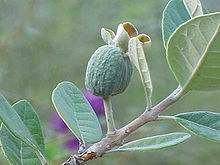Brazilian guava
| Brazilian guava | ||||||||||||
|---|---|---|---|---|---|---|---|---|---|---|---|---|

Brazilian guava ( Acca sellowiana ), |
||||||||||||
| Systematics | ||||||||||||
|
||||||||||||
| Scientific name | ||||||||||||
| Acca sellowiana | ||||||||||||
| ( O.Berg ) Burret |
The Brazilian guava ( Acca sellowiana ), also known as feijoa or pineapple guava , is a species of the myrtle family (Myrtaceae).
description
The Brazilian guava is a slowly growing, evergreen shrub or small tree that reaches heights and crown diameters of around 4 to 6 meters. The flaking bark is grayish to brownish.
The dark green, thick and elliptical, lanceolate or oblong to obovate leaves are tomentose on the underside, they are up to 6 cm long. They are short-stalked, entire and rounded to pointed. The short petiole is furrowed. The veins are pinnate and embossed in relief on the top.
The stalked, white to crimson, reddish-colored, edible and hermaphrodite flowers have five, sweeping bloom and lots of red, rather stiff stamens . They appear axillary and individually. The flower stalks and the elongated cylindrical flower cup are white felt. There are very small, hairy prophylls . The boat-shaped sepals are green and white felted on the outside and white-reddish and bald on the inside. The slightly hairy petals are boat-shaped and outside white to slightly reddish and finely pitted, inside they are purple to reddish in color. The multilocular ovary is inferior with a long reddish and conical stylus with capitate scar . There is a discus .
The pollination happens in culture, especially by bees ; the nature of the stamens suggests that the wild form is pollinated by bats or birds .
When ripe, the greenish-yellowish to dark green, round or egg-shaped to ellipsoidal and about 5–12 centimeters large, sometimes “frosted”, smooth and slightly textured and slightly ribbed fruits ( berries , pancake berries , a false fruit ) are reminiscent of small avocados . The calyx lobes are preserved at the top. The flesh is white to yellowish, brownish and has the consistency of a soft pear. The strongly fragrant fruits taste like a mixture of pineapple and strawberries when they are ripe , slightly sour and refreshing. The many (20–40) small, flattened seeds are light to orange-brownish and about 1.8–3 millimeters in size. The fruits weigh 40–150 grams.
distribution
The Brazilian guava originally comes from southern tropical America : southern Brazil , northern Argentina , western Paraguay and Uruguay , where it grows in the mountains.
Today it is also grown in Eurasia , especially Central Asia . Since it is a relatively undemanding plant, it is widely known as a fruit in the CIS countries (growing areas including Georgia and Azerbaijan). More recently, the plant has also been grown successfully in Sicily. The season for European fruits is September and October (location: Adrano , Sicily ). Under the name Feijoa, it is a relatively popular garden plant in New Zealand . The fruits are widely available, also processed as juice, wine or in yoghurt.
use
The ripe fruit can be eaten like a kiwi. Feijoa is suitable for making compote. The fruits are ideal for making bread spreads. Finely chopped up, mixed with sugar and filled into glasses, the fruit pulp can easily be kept in the refrigerator for many weeks. The high vitamin and iodine content of the fruits should be emphasized . You can freeze the fruits for up to a year without any loss of quality.
Care as a container plant
This species is very suitable as a container plant. The eye-catching flowers appear on the balcony and terrace from May, often earlier under glass. The plants are not attacked by pests. The best location is a cold, temperate and warm winter garden. When planted out, it can withstand temperatures down to −12 ° C. It freezes to death in the pot at temperatures below −8 ° C.
Systematics
The first description was made of this kind in 1854 by Otto Karl Berg in Linnaea as Orthostemon sellowianus O.Berg ( Basionym ). Another synonym is Feijoa sellowiana (O.Berg) O.Berg . This kind was 1941 by the German botanist Carl Burret in Feddes Repert. Spec. Nov. Regni Veg. in the genus Acca O.Berg , placed as Acca sellowiana .
literature
- Marilena Idžojtić: Dendrology. Academic Press, 2018, ISBN 978-0-444-64175-5 , p. 43, limited preview in Google Book Search.
- Jules Janick, Robert E. Paull: The Encyclopedia of Fruit and Nuts. CABI, 2008, ISBN 978-0-85199-638-7 , pp. 526-532.
- Elhadi M. Yahia: Postharvest Biology and Technology of Tropical and Subtropical Fruits. Vol. 3: Cocona to mango , Woodhead, 2011, ISBN 978-1-84569-735-8 , pp. 115-133.
Web links
- Acca selloiana at Useful Tropical Plants.
Individual evidence
- ^ Feijoa near tropical country.
- ↑ Linnaea, 27 (4), p. 440, first description scanned at botanicus.org .
- ↑ Repertorium specierum novarum regni vegetabilis, 50, p. 59.
- ↑ Entry in GRIN - Taxonomy for Plants.



